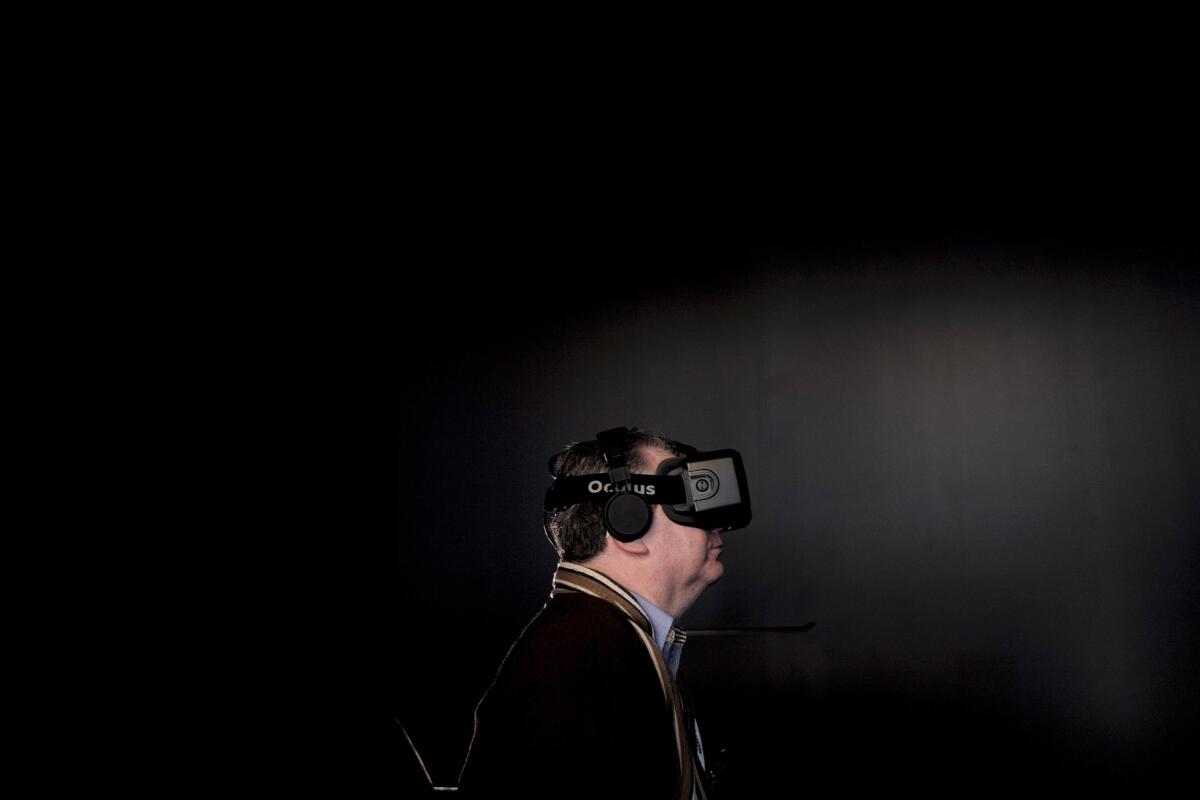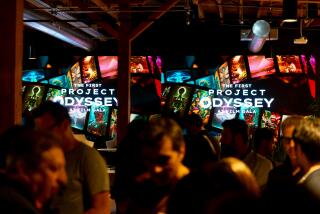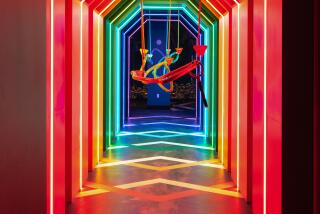Sundance 2015: The pleasures and perils of VR cinema

- Share via
During an informal event thrown by the virtual-reality company Oculus last week at the Sundance Film Festival, one of the company’s new hires was explaining his team’s process for creating an animated short.
“What we realized, after all this research, is that sometimes [viewers] need a quiet moment,” said the creator, the former Pixar staffer Max Planck, as he and I talked about pacing in VR shorts, the movies that Planck and another Pixar-turned-Oculus honcho named Saschka Unseld were creating. “Because if it’s just all noisy moments, we’re going to lose people.”
There has been nothing quiet about what Oculus and its cohorts have been doing lately. VR has become a buzzword, trend and movement all rolled into one, one of those things some trumpet as the future while other pronounce over--even as many others barely knew it had begun. (There is a little truth, of course, in all of those characterizations.)
For roughly 100 years, on-screen entertainment has been consumed in pretty much the same way—with a rectangular screen maintained at some distance from our eyes. The size of the screen has changed, and what we’re able to put on that screen has grown by leaps an bounds. But the essence of the experience has not.
VR changes the equation. Entertainment in the format is not held—literally or in any other way--at a remove. By viewing the images-- via a headset or next-generation smart phone (consumer platforms are slow but coming) right up against your eyes--you are inside whatever you’re watching. Wherever you look, you remain in the same forest, sea, sky or other universe you happen to be in, in the same spherical space. You experience the world from within.
Discussions about VR often involve the mention of 3-D. The comparison makes sense, in a way--it is a new format that can enhance the realism of films and television. But to those on the front lines it can also seem inadequate. With it ability to plunge a user into a different reality—a reality that does not disappear if you try to look elsewhere—the VR format makes a quantum leap over even the richest creations of a James Cameron or Alfonso Cuaron. (The introduction of sound, color and moving pictures to cinema may be more accurate analogies, though limiting in their way too.)
Sundance officially hosted nearly a dozen VR exhibits, each offering its own tantalizing and sometimes fraught suggestion of where all this can go. I’ve never really liked the term that a technology has “come of age,” but all these exhibits at the festival--the combination of traditional stories and visual poems, of animation and live-action pieces, of big companies like Google and Facebook (owner of Oculus) and plucky individuals, combined to make it feel like we were indeed experiencing a moment.
There will be plenty other such moments ahead, and many will probably make this one seem naive. There will also be many more answers ahead—we haven’t even figured out how to ask the right questions. But the presence of these exhibits began to point us in certain directions, and toward some of those questions.
Will VR be a narrative experience or something more experiential?
What genres make sense for this kind of full-on cinema experience, and what comes up lacking?
Even more complex, both narratively and ethically: is there such a thing as too much immediacy? At Hollywood studios every day, producers and animators strive to make films more present, more tangible, more immediate. But they rarely stop to contemplate a simple question: what happens if they’re too successful?
VR legitimizes that question. It poses the conundrum of what happens when entertainment delivers on its promise of putting you “there,” but there may not be a place you really want to be.
That issue came up most pressingly with “Perspective,” a two-part piece about campus sexual assault from the traditional filmmaker Rose Troche (“The Safety of Objects”) and the more tech-minded Morris May. In the piece, one attends a college party, in the first part as a man and then in the second part as a very inebriated woman who the man and his friend sexually assault.
“Perspective” is VR of the most first-person kind—when you look down at a hand or at your shoe, you feel like it’s your hand and shoe. When the character walks; you are (through the Oculus headset) walking with them. When a man stands next to a bed on which he’s contemplating a rape, you are too; when you’re behind the woman’s eyes and see the attackers loom above you, they appear to be really looming above you.
It’s disorienting and dizzying—in part because the movements are a little more jolting than other VR pieces but also because the content itself is so upsetting.
That is, its creators say, by design. Troche and May are trying to put us in the moment (they plan a larger series, in which other dualities are explored, including a police officer and a criminal suspect), using the radical immersion of VR to give voice to subjective experience.
“We have had some people come out and say ‘Why did you just eye-rape me?” Troche said. “But the feedback has been very positive. We’re just trying to give you a different perspective, like the name says.”
The afternoon I watched “Perspective,” James Franco did too, emerging from the first part to register his approval. Others were similarly moved, and the director Rodrigo Garcia and Sundance founder Robert Redford also stopped by to see it. There’s no doubt that Perspective takes advantage of VR to achieve an intimacy unlike any conventional drama. But it also raises the question of how much reality we want in our films and TV shows--an issue that traditional cinema has never had to grapple with.
Other less charged, but no less interesting, questions dance at the edges of many VR pieces. For instance, How much interactivity do we want in VR cinema? The form was originally thought of as primarily ideal for gaming, but now, like so many digital forms, it is sprouting forth in ways its inventors never intended, including to film and TV-style entertainment.
In “Way to Go,” an animated piece directed by the French-Canadian filmmaker Vincent Morriset and a group of Quebecois artists (it includes the Grammy-winning designer Caroline Robert), one moves as if in a video game, following a ghostly character through various landscapes. Except the experience is deeply cinematic, conjuring up metaphors and meaning—think a more playful Malick--as one runs and jumps through the environment.
“We wanted it to feel like a film but have a through line,” said Morriset when I talked to him and his collaborators at the festival. “But how much freedom we should give the viewer as opposed to telling them a story? That’s one of the questions we struggle with every day.”
These are issues that depend, of course, on the goal of the piece. A flying simulator called “Birdly”--the least cinematic of the Sundance experience; it’s essentially a ride--replicated the feeling of flying over San Francisco as you lie face down on a full-bodied contraption and peer through a headset. Nonny de la Pena, alteratively, continues to offer what might be called VR journalism; in her new piece, one walks through the streets of Syria (hers are among the few pieces one can physically around walk in) as a bomb shatters the daytime calm.
VR filmmakers also engage in what might be called ”invisible interactivity”—that is, a film subtly changing based on your habits without you even realizing it.
In “Wild,” the Montreal-based collective Felix and Paul--articulate types who are pioneering a lot of virtual reality cinema content--have created a new piece of content to go with the Reese Witherspoon film. It’s a marketing short but it plays like a film; the pair shot it separately with Witherspoon and co-star Laura Dern after meeting with Searchlight at the Toronto International Film Festival.
What they’ve ended up with seems like an outtake from the film but is experienced in a very different way.
As the “Wild” VR experience begins, you find yourself sitting in a peaceful forest when Witherspoon, gear in tow, trudges up to you, looking much as she does in the film. She sits on a tree stump, narrating her thoughts. Soon enough she appears to looks over to you, but if you turn your head you see she’s actually looking at Dern’s character, the ghost of her mother, who will appear (giving you a start) and begin talking the second before you turn your head in her direction.
There is something sneakily effective about the piece—it places the user in a familiar setting (you are living inside a movie you already saw traditionally, an eerie experience) and it also deploys a technique that would be chilling (perhaps too chilling) if applied in a horror movie.
But there is also something else happening—the Dern character, through a complicated algorithm, will materialize differently depending on how and when you turn to look at her.”
“We wanted you never to actually see her appear,” said Paul when I asked him about the piece’s approach. “And we want her to appear differently depending on who you are”
If you turn sooner in Witherspoon’s monologue, Dern appears then. If you wait, she’ll appear later. And if you never turn, she’ll never appear--which will make her voice-over, which initiates regardless, seem like it’s coming from above, or your own thoughts.
These are not things that would ever happen in a movie theater.
That invisible interactivity is also at work in the Oculus-produced “Lost.” The short deposits you in a kind of otherworldly foliage when a robotic pet arrives, followed by a much larger owner overlord who wreaks some havoc. The short earned some mixed reviews for not being involving enough—and Planck, Unseld and fellow Oculus collaborator Edward Saatchi acknowledge it’s a first film, with all the attendant glitches. But my experience was different.
Perhaps it was a matter of novelty—the pure cinema experience of the kind offered by Pixar now ported to the VR world—but the short has a thrilling quality to it. The idea of standing on another planet while fireflies buzz, robots land and Pixar-like action happens is such a jolt that it satisfies even if all the storytelling kinks haven’t been worked out.
Planck said this may yet be the beginning of a larger episodic tale with “Lost” (full-fledged features are expensive and not-entirely-user-friendly in VR; episodic shorts may be the way this next flowers). Oculus and its subsidiary Story Studio are testing these theories every day, devising a new language as they go. Planck, for instance, calls the body English that shifts early in the viewing of a VR film the “moment of surrender,” a wonderfully descriptive phrase--and one that’s useful, since different users might experience theirs at different points.
VR filmmakers can adjust to this too.
“If someone looks around frantically, we can slow things down for them, and if they’re more passive, we can speed it up,” Planck said. “And they wouldn’t know it was even happening.”
Think of it as a kind of pacing personalization, though that raises another question, one that critics, among others, would be very interested in: if you and I see the same movie, are we really seeing the same movie?
There will be plenty more forays, of various kinds—from Oculus (there’s a comedy in the form of “Kabloom” in the works as well as a more experiential piece called “Bullfight” that’s mean to put you in the ring, matador-style); from the “Maleficent” director Robert Stromberg, who has joined up with the effects studio Third Floor to create VR pieces; from many other Hollywood and not-so-Hollywood types.
The veteran director Mark Romanek is advising the VR company Jaunt, which has created a nifty little monster proof-of-concept for the homemade Google Cardboard platform. The visual artist Chris Milk is doing some of the more interesting work, recently completing a new piece called “Evolution of Verse,” with birds and babies unleashed to intense if slightly melodramatic effect.
And Fox Searchlight, the company behind movies like this season’s “Wild” and “Birdman,” has been particularly aggressive (the mind wanders at what it would be like to live inside the latter’s world.)
It can be almost unsettling at first, when watching VR, to realize how fully in the grasp of the story you’ve become, like you’ve given up control no one’s previously asked for. But the psyches adjust quickly, and the experience can become indispensable.
Sitting in a traditional movie screening—even a good traditional movie screening--felt deficient after the experience of watching VR shorts, like someone had drained the thing of light and realism. In fact, paradoxically, real life-the original VR experience--seems a little lacking too. That can be both good and bad, and a lot of people are working--probingly, uncertainly, furiously--trying to figure out what spells the difference between the two.
Twitter: @ZeitchikLAT
More to Read
Only good movies
Get the Indie Focus newsletter, Mark Olsen's weekly guide to the world of cinema.
You may occasionally receive promotional content from the Los Angeles Times.











